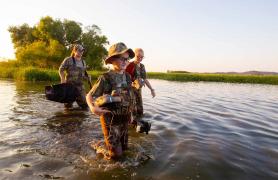Count the ways wild critters alleviate winter’s woes.
How do animals tolerate the winter weather that refrigerates the Show-Me State? Humans can relocate to cozy homes and wait for temperatures to moderate. Wild critters aren’t so fortunate. It’s their fate to operate in winter’s freezing climate. But, wait. Animals have eight great traits to help them compensate.
Migrate
Many birds, such as this blackburnian warbler, say “I’m outta here!” when winter arrives. They fly to warmer places where there’s more food for them to eat. Birds aren’t the only animals that migrate. Some bats, fish, and even butterflies head south for winter, too. For example, monarchs are famous for flying thousands of miles to reach their winter home in Mexico.
Terminate
Grasshoppers, mosquitoes, and many other insects lay eggs before winter arrives. The adults die when the first hard freeze hits, leaving the babies to fend for themselves when they hatch the following spring. Grasshoppers lay their eggs in soil where it’s weedy, grassy, or crop-covered. Different kinds of grasshopper eggs hatch at different times, which is why you can see grasshoppers throughout the spring and early summer.
Congregate
When you’re cold, do you ever snuggle up with your family or friends? Animals do. Quail, ducks, and geese gather together, or congregate, to keep cozy. Squirrels, raccoons, and honeybees huddle up in hollow trees or other hidey-holes to conserve heat.
Brumate
Snakes, like the quail pictured here, snuggle too, and some aren’t choosy about who they curl
up with. Venomous copperheads and harmless western ratsnakes have been known to congregate in burrows below the frost line. How do they cope as roommates in such close quarters? They brumate (broo-mate).This is a special survival trait that only reptiles and amphibians have. These cold-blooded critters can’t move much when temperatures drop, so their bodies slow waaaaay down. When it’s warm enough to relocate, they activate and skate their separate ways.
Pupate
Some insects ride out winter as a pupa (pyoo-puh). Think of a pupa as an insect’s teen years — a time when the baby bug changes into an adult. Lots of insects, including this Polyphemus moth, form a cocoon when they pupate. Some even have antifreeze in their bodies to keep them from turning into bugsicles when temperatures tank. If you find a Polyphemus moth cocoon, leave it be, and then check it next June. You’ll findit empty — with an opening at the top that makes it look like a little shoe.
Insulate
Critters don’t wear big puffy coats, but they have something just as good to insulate their bodies against winter’s chill: fur and feathers. Red foxes and other mammals grow thick fur coats to keep them cozy. Birds fluff up their feathers to trap warm air next to their skin, like the way a down comforter keeps you warm at night.
Excavate
Voles, mice, and shrews plow tunnels under the snow. The snow hides the furry mammals from hungry predators and acts like a fluffy white blanket, keeping the tunnel much warmer than the air outside. To see how toasty snow can be, build an igloo.
Generate
We use electricity or burn natural gas to generate heat in our houses. Animals, including humans, generate heat from the foods they eat. For animals trying to survive winter, being overweight is great. Not only does extra fat help insulate their bodies, but they also can use the fat to generate heat. Although red-tailed hawks have feathers to keep them warm, fatty foods like seeds and chunky rodents help them generate heat from the inside.
Hibernate
A few animals treat winter like a boring movie — they sleep through it. Chipmunks, skunks, and bears take long, deep naps during the worst winter weather. In fact, a bear doesn’t even wake up to pee or poop. Instead, it stores a poop plug and pops it out soon after waking up in the spring. Bats, woodchucks, and ground squirrels sleep even deeper — they hibernate. During hibernation, an animal’s temperature drops, and its breathing and heart rate slow way down. If your heart slowed as much as a hibernating ground squirrel’s, you’d never wake up!




















Also In This Issue

This Issue's Staff
Les Fortenberry
Angie Daly Morfeld
Noppadol Paothong
Marci Porter
Mark Raithel
Laura Scheuler
Matt Seek
David Stonner
Stephanie Thurber
Cliff White






















